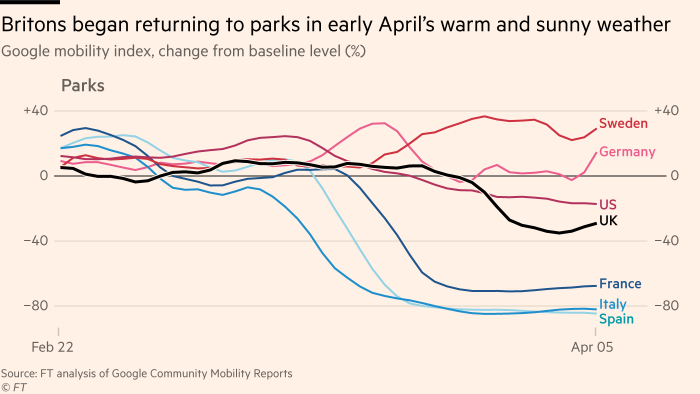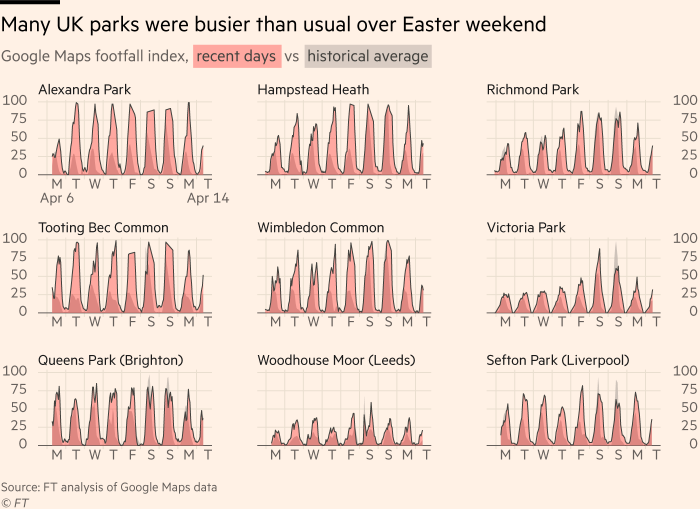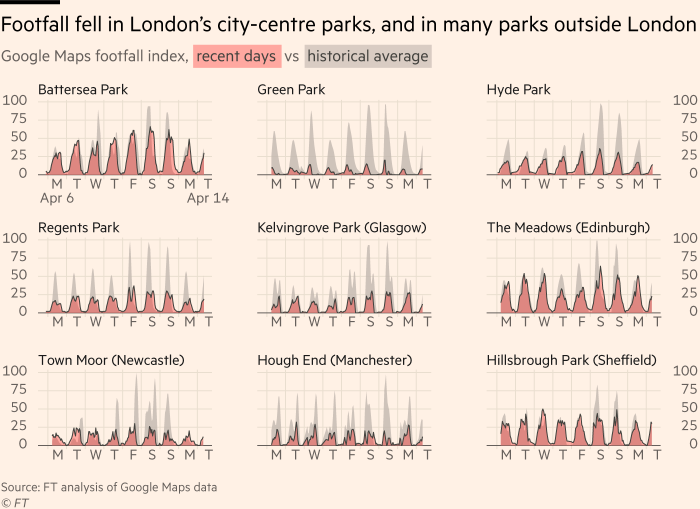The UK public has largely obeyed the coronavirus lockdown although, over Easter weekend, visits surged in some parks, according to Financial Times analysis.
Data capturing transport and footfall in shops during the first two weeks of strict social distancing measures — limiting Britons from leaving home except for shopping, exercise, medical care and most work — show a high level of adherence.
But data from the bank holiday weekend, capturing the use of outdoor spaces, illustrates the challenge facing authorities when the public’s willingness to remain indoors is tested by better weather.
With lockdown announced on March 23, by the end of the first week of April the number of people in shops and recreational areas had fallen 78 per cent compared to the same period in recent years, according to Google data captured under its Community Mobility initiative, set up in response to the pandemic. The number of people using the UK’s public transport network had decreased 73 per cent over the same period.
The public initially responded well to guidance on using parks for exercise only. Google showed a 54 per cent drop in visitors in the first week after the lockdown announcement.
But warm weather over the first weekend of April led to a sharp jump in the use of outdoor spaces leading to footfall only declining by 30 per cent compared to the same weekend on average over the past few years.
According to the data, the UK lags France, Spain and Italy in its adherence to the lockdown — even though those nations have stricter measures. But it remains ahead of many others including the US, Germany and Austria, which have similar restrictions to the UK. It is also ahead of Sweden, which remains an outlier with its lax social distancing measures.

Before the lockdown was announced by Boris Johnson, prime minister, the government had issued guidance asking people to avoid restaurants, bars and non-essential travel. This proved ineffective, forcing the government to give police the powers to enforce social distancing and to fine those who refused to co-operate.
Senior government figures said they were pleased with the public’s response. “The lockdown has been far more successful than expected,” said one cabinet minister, adding that people had responded much better than expected.
Editor’s note

The Financial Times is making key coronavirus coverage free to read to help everyone stay informed. Find the latest here.
Another senior official suggested that reports from other European countries about the strain which the pandemic had put on health services had helped convince people to stay at home.
The government has insisted parks should remain open because exercise is important to mental and physical health, ministers and health officials said. Some local authorities have had to intervene and close green areas, at least temporarily, after crowds ignored social distancing guidance.
Sadiq Khan, mayor of London, welcomed the public’s response: “Londoners have risen to the challenge”, he said, because “they know it is the right thing to do. We are in the middle of a global emergency like no other and I want to thank Londoners for following the rules and making huge personal sacrifices that would have seemed unimaginable just a month ago.”

But the public’s discipline appeared to have weakened again over the Easter weekend, according to the FT’s own analysis of footfall data taken directly from Google Maps.
Visitor levels in 34 parks on Saturday, April 11 and Sunday, April 12 were back to normal levels on average over the same weekend in recent years. In some areas, footfall had increased.

In London’s Alexandra Park, Tooting Bec Common and Wimbledon Common as well as Salford’s Peel Park in Greater Manchester, footfall was more than double its typical level for the second weekend of April.
In other largely residential parts of the capital, such as Richmond Park, the number of visitors increased to several times their weekday and typical weekend levels. The same was true for Woodhouse Moor in Leeds.
Other areas of the country appeared to show more discipline. Visitors over the Easter weekend to Kelvingrove Park in Glasgow and Town Moor in Newcastle, were half their usual levels. The Meadows of Edinburgh and Manchester’s Hough End playing fields also showed a decrease.
The number of visitors to parks in central, less exclusively residential, areas of the capital, such as Green Park and Hyde Park, also fell.


















